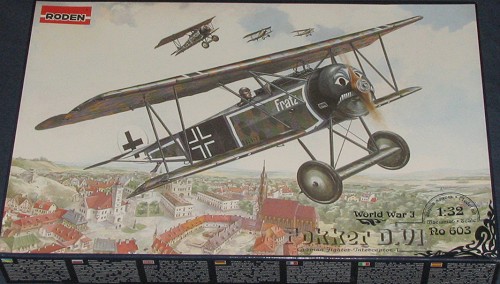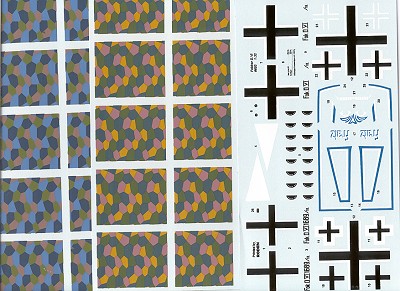|
KIT: |
Roden 1/32 Fokker
D.VI |
|
KIT #: |
603 |
|
PRICE: |
$37.98 MSRP ($33.96
from Squadron) |
|
DECALS: |
Three options |
|
REVIEWER: |
Scott Van Aken |
|
NOTES: |
|

During the middle of 1917 the
principal German fighters, the Albatros D.III and D.V, lost their
superiority in the skies of the Western Front, and now the Sopwith Camel
and S.E.5a dominated in the air. At this time the German Air Command (Idflieg)
called all manufacturers to take part in the Fighter Competition planned
for January 1918.
Fokker Flugzeugwerke, led by the genius Anthony Fokker, had a strong
reputation among pilots because by this time the Fokker Dr.I had already
become a legend of the air. When the Fighter Competition started at
Adlershof on January 20, 1918, Fokker Flugzeugwerke proposed eight
prototypes. Many of them were very ambitious, but all German
manufacturers at this time had a common problem: the lack of a powerful
engine. All the new designs were based on 'good old' engines like the
air-cooled Oberursel Ur.II or the inline Mercedes D.IIIa. During the
competition none of the all-new designs achieved the desired results but
Fokker's V.13 design, developed from the V.9, showed some promise and was
declared a winner. Some aspects of its performance like climb were
unsatisfactory, but other fighters like the Pfalz D.VI had rather worse
figures. Idflieg announced a new Fighter Competition but for now Fokker
received an initial contract for 120 aircraft, which received the
official designation Fokker D.VI.
The first production example was accepted on April 26, 1918 and by August
sixty aircraft of this type had been produced. Contracts for sixty more
were cancelled because at this time the Fokker D.VII entered service.
This new design was superior to the D.VI in every way.
The majority of all 60 D.VIs built were delivered to the Kampf Einsitzer
Staffeln, special units created mainly for the intercepting of Allied
bombers. The Fokker D.VI which had an air-cooled engine and could
take-off without delay was a good choice for this role. But the climbing
ability of the D.VI was still poor and the fighters were dispersed in the
Alsace-Lorraine region where bombing raids were less frequent. Other
machines were delivered to the training units; and Austria-Hungary
purchased seven aircraft of this type. After the end of the war at least
two D.VIs were tested in France and the USA.
Overall, the Fokker D.VI was overshadowed by the most successful types
like the Fokker Dr.I and Fokker E.V/D.VIII and, obviously, by the
magnificent Fokker D.VII. With only sixty built, it might seem to have
vanished in an ocean of fighters, but the D.VI played its own small role
in the sky battles of World War One.
 I
must say that I was quite surprised to see this kit. Like a huge number of
modelers, I'd never heard of the Fokker D.VI. Sure, we figured there was an
aircraft before the D.VII, but had not thought too much about what it was.
Well, it turns out to have been basically a biplane Dr.I. The upper wing is
what you'd find on a D.VII, while the lower wing is what was found on the
Dr.I.
I
must say that I was quite surprised to see this kit. Like a huge number of
modelers, I'd never heard of the Fokker D.VI. Sure, we figured there was an
aircraft before the D.VII, but had not thought too much about what it was.
Well, it turns out to have been basically a biplane Dr.I. The upper wing is
what you'd find on a D.VII, while the lower wing is what was found on the
Dr.I.
This makes for a very easy and
interesting variation on Roden's excellent 1/32 Fokker Dr.I. What you have
is a nice rotary-engined biplane with very little rigging. Only the landing
gear and the control lines are needed. Everything else is just like the
earlier Dr.I kit. Same fuselage, same interior, same engine and the
empennage. I'll cheat a bit and direct you to the
Dr.I preview to get a feeling for these things. Only one sprue was
altered and that is the one that has the upper wing and wing tips. There is
also an additional bit on two other sprues for the N struts. I was a bit
surprised to see some flash on the upper wing sprue, but since it is on the
sprue itself, I guess it really doesn't count.
Instructions are typical of Roden in
that they are well drawn and offer a nice rigging diagram. Color
information is by Humbrol number and generic name. There are thre e
huge decal sheets with this one. One sheet is upper lozenge, another is
lower and the third has the insignia and other markings. I'll leave it to
the experts to discuss the correctness of the colors on the lozenges, but
they look OK to me. They are also specific for certain parts of the
airframe. A placement guild is provided. Naturally, some trimming will be
needed. Recent Roden decals have been excellent and I do hope that these
are also as good. Markings for three aircraft, all from mid 1918 onward.
e
huge decal sheets with this one. One sheet is upper lozenge, another is
lower and the third has the insignia and other markings. I'll leave it to
the experts to discuss the correctness of the colors on the lozenges, but
they look OK to me. They are also specific for certain parts of the
airframe. A placement guild is provided. Naturally, some trimming will be
needed. Recent Roden decals have been excellent and I do hope that these
are also as good. Markings for three aircraft, all from mid 1918 onward.
They include:
- Fokker D.VI, 689/18, w/n 2646, the
Flugpark Armee Abteilung B, based at Alsace-Lorraine sector, June 1918.
- Fokker D.VI, the home-defence
Staffel, Kest 1a, based at Mannheim, Summer 1918.
- Fokker D.VI, "Fratz", Jasta 80b
(Bavarian), pilot Leutnant Kurt Seit, Western Front, Summer 1918.
This last one is the box art aircraft
and the more colorful of the three.
I have no doubt that this one will be received with glad cries by the WWI
crowd as I do think this is the first mass media kit of this type ever
done. Judging from my most pleasant experiences with the Dr.I, this should
be a real beauty as well.
September 2005
You can find this kit and many others at

If you would like your product reviewed fairly and fairly quickly by a
site that has nearly 300,000 visitors a month, please
contact
me or see other details in the
Note to
Contributors.
Back to the Main Page
Back to the Previews Index Page


 I
must say that I was quite surprised to see this kit. Like a huge number of
modelers, I'd never heard of the Fokker D.VI. Sure, we figured there was an
aircraft before the D.VII, but had not thought too much about what it was.
Well, it turns out to have been basically a biplane Dr.I. The upper wing is
what you'd find on a D.VII, while the lower wing is what was found on the
Dr.I.
I
must say that I was quite surprised to see this kit. Like a huge number of
modelers, I'd never heard of the Fokker D.VI. Sure, we figured there was an
aircraft before the D.VII, but had not thought too much about what it was.
Well, it turns out to have been basically a biplane Dr.I. The upper wing is
what you'd find on a D.VII, while the lower wing is what was found on the
Dr.I. e
huge decal sheets with this one. One sheet is upper lozenge, another is
lower and the third has the insignia and other markings. I'll leave it to
the experts to discuss the correctness of the colors on the lozenges, but
they look OK to me. They are also specific for certain parts of the
airframe. A placement guild is provided. Naturally, some trimming will be
needed. Recent Roden decals have been excellent and I do hope that these
are also as good. Markings for three aircraft, all from mid 1918 onward.
e
huge decal sheets with this one. One sheet is upper lozenge, another is
lower and the third has the insignia and other markings. I'll leave it to
the experts to discuss the correctness of the colors on the lozenges, but
they look OK to me. They are also specific for certain parts of the
airframe. A placement guild is provided. Naturally, some trimming will be
needed. Recent Roden decals have been excellent and I do hope that these
are also as good. Markings for three aircraft, all from mid 1918 onward.
